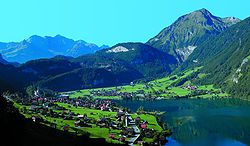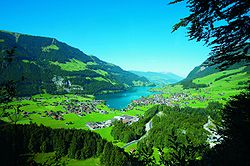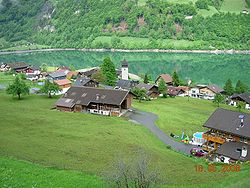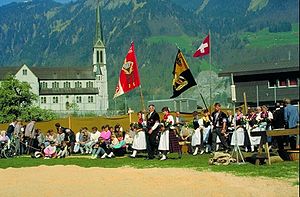
Lungern
Encyclopedia
Lungern is a municipality
in the canton
of Obwalden
in Switzerland
. Lungerersee
is located within the municipality.
 The village of Lungern lies 750 metres (2,460.6 ft) above sea level in the highest part of the canton of Obwalden, on the lake of Lungern and at the foot of the Brünig Pass. It is the highest village of the Sarneraa-Valley, and is situated in a basin that is open only to the north and is surrounded on all other sides by steep and woody inclinations and rocks.
The village of Lungern lies 750 metres (2,460.6 ft) above sea level in the highest part of the canton of Obwalden, on the lake of Lungern and at the foot of the Brünig Pass. It is the highest village of the Sarneraa-Valley, and is situated in a basin that is open only to the north and is surrounded on all other sides by steep and woody inclinations and rocks.
The municipal district of Lungern has an area of 46.33 square kilometres (11,448.4 acre), of which 6.48 square kilometres (1,601.2 acre) are meadow and tilled land, 19.2 square kilometres (4,744.4 acre) are pastureland, 15.97 square kilometres (3,946.3 acre) are wooded and the remaining 2.91 square kilometres (719.1 acre) are unproductive.
The village of Lungern is divided into three districts: on the northern part of the lake is Kaiserstuhl/Bürglen; the town center lies on the eastern side of the lake; and the hamlet Obsee is situated on the southern side of the lake and might be the best maintained part of the old village. There you will still find old houses in their original structure and style.

 In 1861 it became easier to reach the village with the construction of the old road over the Brünig pass. A quarter century later, in 1886, the first mail
In 1861 it became easier to reach the village with the construction of the old road over the Brünig pass. A quarter century later, in 1886, the first mail
carriages came over the pass. However, this only lasted two years, in 1888 the railroad from Brienz
to Alpnachstad (now part of Alpnach
) opened. In 1887 the Eibach river flooded causing damage to the old village church. Six years later, in 1893, was the consecration of the neo-gothic
style church. At the end of the 18th century the population of Lungern lowered the level of the lake, with great effort and over many years, in order to improve living conditions. The works created new land for agriculture, housing, and a sawmill. Within 80 years the hard-won land was lost to a new dam: in 1922 a company named CKW built and started running a power station located at the lake. Nowadays the local power station (EWO) produces electricity from the power of the water of the Lungerersee. In 1942 the railroad line over the Brünig pass was electrified.
In the 2007 federal election
the most popular party was just classed as other, which received 41.7% of the vote. The next three most popular parties were the SVP
(26.2%), the CVP
(25.6%) and the SPS
(6.5%).
The entire Swiss population is generally well educated. In Lungern about 71.5% of the population (between age 25-64) have completed either non-mandatory upper secondary education or additional higher education (either university or a Fachhochschule
).
 Lungern has an unemployment rate of 0.6%. , there were 156 people employed in the primary economic sector and about 66 businesses involved in this sector. 443 people are employed in the secondary sector and there are 27 businesses in this sector. 394 people are employed in the tertiary sector, with 54 businesses in this sector. About 24% of the workers are involved in agriculture and forestry, 40% are considered artisans or craftsman. Of the rest of the working population, 13% are in commercial business or teaching staff, 12% are self-employed and 11% are domestic and hotel employees.
Lungern has an unemployment rate of 0.6%. , there were 156 people employed in the primary economic sector and about 66 businesses involved in this sector. 443 people are employed in the secondary sector and there are 27 businesses in this sector. 394 people are employed in the tertiary sector, with 54 businesses in this sector. About 24% of the workers are involved in agriculture and forestry, 40% are considered artisans or craftsman. Of the rest of the working population, 13% are in commercial business or teaching staff, 12% are self-employed and 11% are domestic and hotel employees.
Economically, agriculture, forestry and wood-working are predominant. Agriculture comprises cattle-breeding and dairy-farming. All of the agricultural farms are cultivated by native highlanders, and they are mainly situated not in the bottom of the valley but on its slopes.
. The wettest month is August during which time Lungern receives an average of 163 mm (6.4 in) of precipitation. During this month there is precipitation for an average of 14.4 days. The month with the most days of precipitation is June, with an average of 14.7, but with only 158 mm (6.2 in) of precipitation. The driest month of the year is October with an average of 88 mm (3.5 in) of precipitation over 14.4 days.
Municipalities of Switzerland
Communes , also known as municipalities, are the smallest government division in Switzerland, numbering 2,596 . While many have a population of a few hundred citizens, the largest cities such as Zürich or Geneva also have the legal status of municipalities...
in the canton
Cantons of Switzerland
The 26 cantons of Switzerland are the member states of the federal state of Switzerland. Each canton was a fully sovereign state with its own borders, army and currency from the Treaty of Westphalia until the establishment of the Swiss federal state in 1848...
of Obwalden
Obwalden
Obwalden is a canton of Switzerland. It is located in the centre of Switzerland. The population is 33,997 of which 4,043 are foreigners. Its capital is Sarnen. The canton contains the geographical centre of Switzerland.-History:...
in Switzerland
Switzerland
Switzerland name of one of the Swiss cantons. ; ; ; or ), in its full name the Swiss Confederation , is a federal republic consisting of 26 cantons, with Bern as the seat of the federal authorities. The country is situated in Western Europe,Or Central Europe depending on the definition....
. Lungerersee
Lungerersee
The Lungerersee is a small natural lake in Obwalden, Switzerland which is named after the town Lungern on its shore. It is used as reservoir....
is located within the municipality.
Geography

The municipal district of Lungern has an area of 46.33 square kilometres (11,448.4 acre), of which 6.48 square kilometres (1,601.2 acre) are meadow and tilled land, 19.2 square kilometres (4,744.4 acre) are pastureland, 15.97 square kilometres (3,946.3 acre) are wooded and the remaining 2.91 square kilometres (719.1 acre) are unproductive.
The village of Lungern is divided into three districts: on the northern part of the lake is Kaiserstuhl/Bürglen; the town center lies on the eastern side of the lake; and the hamlet Obsee is situated on the southern side of the lake and might be the best maintained part of the old village. There you will still find old houses in their original structure and style.
History
The first legal proof of Lungern's existence is contained in a tax register for the diocese of the bishop of Konstanz in Germany dating from the year 1275. It is mentioned as Lutigern and also as de Lungern.

Mail
Mail, or post, is a system for transporting letters and other tangible objects: written documents, typically enclosed in envelopes, and also small packages are delivered to destinations around the world. Anything sent through the postal system is called mail or post.In principle, a postal service...
carriages came over the pass. However, this only lasted two years, in 1888 the railroad from Brienz
Brienz
Brienz is a municipality in the Interlaken-Oberhasli administrative district in the canton of Bern in Switzerland.The village lies on the north bank of Lake Brienz in the Bernese Oberland at the foot of the Brienzer Rothorn mountain.-History:...
to Alpnachstad (now part of Alpnach
Alpnach
Alpnach is a village in the canton of Obwalden in Switzerland.-Geography:Alpnach has an area, , of . Of this area, 32.1% is used for agricultural purposes, while 54.1% is forested...
) opened. In 1887 the Eibach river flooded causing damage to the old village church. Six years later, in 1893, was the consecration of the neo-gothic
Gothic Revival architecture
The Gothic Revival is an architectural movement that began in the 1740s in England...
style church. At the end of the 18th century the population of Lungern lowered the level of the lake, with great effort and over many years, in order to improve living conditions. The works created new land for agriculture, housing, and a sawmill. Within 80 years the hard-won land was lost to a new dam: in 1922 a company named CKW built and started running a power station located at the lake. Nowadays the local power station (EWO) produces electricity from the power of the water of the Lungerersee. In 1942 the railroad line over the Brünig pass was electrified.
Population and Economy
Nowadays the village of Lungern has about 1950 inhabitants. The population is stable, so there is a rise in the ratio of old people to total population. In fact 17.5% of the total population of Lungern are of a pensionable age, compared with an average of 12% in the canton. If work opportunities remain limited this will likely grow even further in the future.Demographics
Lungern has a population (as of ) of . , 8.6% of the population was made up of foreign nationals. Over the last 10 years the population has grown at a rate of 2.6%. Most of the population speaks German (94.8%), with Albanian being second most common ( 2.2%) and French being third ( 0.7%). the gender distribution of the population was 49.7% male and 50.3% female. there are 681 households in Lungern.In the 2007 federal election
Swiss federal election, 2007
Elections to the Swiss Federal Assembly, the federal parliament of Switzerland, were held on Sunday, 21 October 2007. In a few cantons, a second round of the elections to the Council of States was held on 11 November, 18 November, and 25 November 2007...
the most popular party was just classed as other, which received 41.7% of the vote. The next three most popular parties were the SVP
Swiss People's Party
The Swiss People's Party , also known as the Democratic Union of the Centre , is a conservative political party in Switzerland. Chaired by Toni Brunner, but spearheaded by Christoph Blocher, the party is the largest party in the Federal Assembly, with 58 members of the National Council and 6 of...
(26.2%), the CVP
Christian Democratic People's Party of Switzerland
The Christian Democratic People's Party of Switzerland is a Christian democratic political party in Switzerland. It is the fourth-largest party in the National Council, with 31 seats, and the largest in the Council of States, with 15 seats. It has one seat, that of Doris Leuthard, on the Swiss...
(25.6%) and the SPS
Social Democratic Party of Switzerland
The Social Democratic Party of Switzerland is the largest centre-left political party in Switzerland....
(6.5%).
The entire Swiss population is generally well educated. In Lungern about 71.5% of the population (between age 25-64) have completed either non-mandatory upper secondary education or additional higher education (either university or a Fachhochschule
Fachhochschule
A Fachhochschule or University of Applied Sciences is a German type of tertiary education institution, sometimes specialized in certain topical areas . Fachhochschulen were founded in Germany and later adopted by Austria, Liechtenstein, Switzerland and Greece...
).
Economy

Economically, agriculture, forestry and wood-working are predominant. Agriculture comprises cattle-breeding and dairy-farming. All of the agricultural farms are cultivated by native highlanders, and they are mainly situated not in the bottom of the valley but on its slopes.
Historic population
The historical population is given in the following table:| year | population |
|---|---|
| 1790 | 1,234 |
| 1850 | 1,413 |
| 1900 | 1,828 |
| 1950 | 1,878 |
| 1990 | 1,859 |
| 2000 | 1,965 |
| 2005 | 1,950 |
| 2006 | 1,975 |
| 2007 | 2,023 |
| 2008 | 2,035 |
Weather
Lungern has an average of 149.5 days of rain per year and on average receives 1491 mm (58.7 in) of precipitationPrecipitation (meteorology)
In meteorology, precipitation In meteorology, precipitation In meteorology, precipitation (also known as one of the classes of hydrometeors, which are atmospheric water phenomena is any product of the condensation of atmospheric water vapor that falls under gravity. The main forms of precipitation...
. The wettest month is August during which time Lungern receives an average of 163 mm (6.4 in) of precipitation. During this month there is precipitation for an average of 14.4 days. The month with the most days of precipitation is June, with an average of 14.7, but with only 158 mm (6.2 in) of precipitation. The driest month of the year is October with an average of 88 mm (3.5 in) of precipitation over 14.4 days.
Churches
There is one Catholic church and one chapel. The church is fairly new, about 110 years old, because the old one got destroyed in a flood of the lake.Leisure time
The main sights of Lungern are:- the old church tower (Alter Kirchturm), a neo-Gothic church, and the hamlet Obsee.
- the aerial passenger tramway for skiers Panoramawelt Lungern Schönbüel
- the underground shooting range Brünig Indoor

